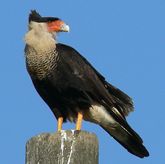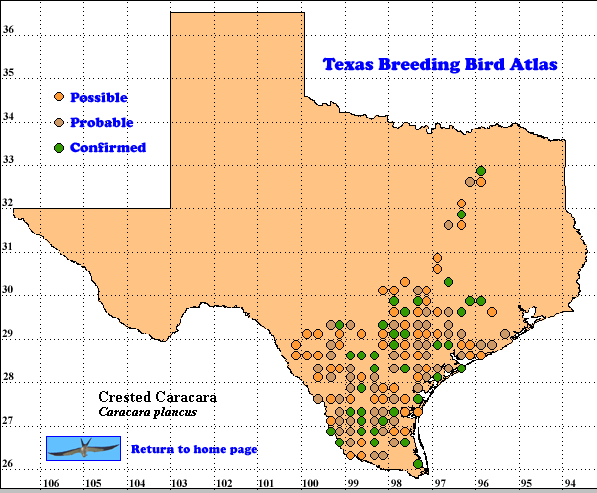Crested Caracaras, in contrast to most raptors, eat carrion as well as any animal they can catch. They are often seen perched on a fence post, tree or utility pole, scanning for live or dead prey or for vultures descending to a carcass. Early mornings and late afternoons are favored foraging times and they also search by flying low or walking on the ground. When prey is spotted from the air, they land and walk to it. (Morrison 1996).
Taxonomy of the 10 or more species of caracaras has been a subject of controversy with some authors placing the group in the family Falconidae (Monroe and Sibley 1993), Others placed caracaras with forest-falcons and Laughing Falcon (Herpetotheres cochinnaus) in a separate group. The AOU Checklist (Am. Ornithol. Union 1998) placed the caracaras in three genera within the subfamily Caracarinae, separate from other falcons. After the publication of the 7th edition of the checklist, the population of Crested Caracaras south of the Amazon River has been separated as the Southern Caracara, which retains the scientific species name plancus. Hence the remaining populations, have a new species name (Morrison 199666, Lockwood and Freeman 2004, Corman 2005).
DISTRIBUTION. During the 1987-1992 field work seasons of the TBBA project, most breeding records were found in the South Texas Brush Country, Coastal Sand Plain, Coastal Prairies and southern Post Oak Savannah and Blackland Prairies region (see the region map in Lockwood and Freeman [2004]). Scattered additional records were found further north in the last region and along the south and southeast edges of the Edwards Plateau. Texas has the largest breeding population of Crested Caracaras of any of the United States, as measured by the Breeding Bird Survey (BBS; Sauer et al. 2005). Crested Caracaras also breed in the United States in Florida and Arizona and through much of Middle and South America to the Amazon River as well as on some Caribbean islands (Howell and Webb 1995, Morrison 1996, Am. Ornithol. Union 1998).
SEASONAL OCCURRENCE. Crested Caracaras are resident in Texas and breed from January to September, based on egg dates from January 30 to June 14 and young in the nest as late as September (Oberholser 1974). TBBA researchers reported fledging dates from mid-March to early May.
BREEDING HABITAT. Crested Caracaras breed in Texas from near sea level to 880 m (2900 ft; Oberholser 1974). TBBA volunteers found caracaras primarily in grassy areas such as: pastures, farmlands,brushlands, open fields and golf courses. These habitats often contained or were adjacent to vegetation such as: low chaparral, mesquite, cactus, thorn scrub, oak, deciduous woods, elm, ash, cedar, hackberry and large rose bushes. In the Coastal Sand Plain of south Texas, caracaras breed in savannas, placing their nests in trees or shrubs with average heights of 5.6 m (19 ft) and canopy diameters of 8.5 m (28 ft; Actkinson et al. 2007). Pairs occupy and vigorously defend territories year-round and usually nest in the highest vegetation or tree-like structure available. TBBA workers found nests mostly at heights of 0.7-3.6 m (2.3-12 ft) above ground with one nest at 9.1 m (30 ft) in a cedar. The pair nay reuse or refurbish an old nest or build a new nest in the same vegetation or structure. Both sexes bring material and help build the well- constructed, woven nest (41-65 cm [16-26 in], across) with a shallow cup (7-18 cm [3-7 in] deep, [TBBA data]). The nest is made of sticks, forb stems, grass and leaves and lined with twigs and finer materials including grass, cotton and Spanish moss. During the nestling period the sides are often compressed to leave a flat platform (Oberholser 1974 , Morrison 1996).The female usually lays 2 (range 1-4) cinnamon-colored eggs, blotched with various shades of brown. Incubation which lasts 30-33 (29-33, TBBA data) days is shared by the parents. The young birds leave the nest 7-8 weeks after hatching and are fed by both parents for at least another 2 months after fledging. Fledglings may remain in their parents territory for as long as 10 months after leaving the nest. Most pairs raise only 1 brood per year. Some pairs attempt a second clutch following a first successful one (10% in Florida). Only 30% of these second clutches were successful. Predation of newly-hatched chicks in late July has been reported in Texas (Dickinson 1990, 1995, 1996. Morrison 1996).
STATUS.Crested Caracaras are considered uncommon to common in the South Texas Brush Country region (Lockwood and Freeman 2004). The breeding and summer symbols on the historic map in Oberholser (1974) suggest breeding occurred in the past over a larger area (as far west as Brewster County) than indicated on the TBBA map below. The map derived from BBS data (Sauer et al. 2005) is similar to the TBBA map. The BBS map indicates a relative abundance of 3-10 caracaras per 40 km (25 mi) route in the South Texas Brush Country. In this region 3 routes with the highest multi-year average counts recorded 9.8 (Guerro, Zapata County), 8.8 (Kingsville, Kleberg Count) and 4.9 (Randado, Jim Hogg County) caracaras, respectively (Price et al. 1995). The data produce an encouraging +5.4% annual population increase for the period 1980-2005.
Text by Robert C. Tweit (2007)
Literature cited.
Actkinson, M. A., W. P. Kuvlesky Jr., C. W. Boal, L. A. Brennan and F. Hernandez. 2007. Nesting habitat relationships of sympatric Crested Caracaras, Red-tailed Hawks and White-tailed Hawks in south Texas. Wilson J. Ornithol. 119: 570-578.
American Ornithologists’ Union. 1998. Checklist of North American birds, 7th ed. Am, Ornithol. Union, Washington, DC.
Corman, T. E. 2005. Crested Caracara (Caracara cheriway). In Arizona Breeding Bird Atlas. pp. 152-153 (T. E. Corman and C. Wise-Gervais, eds.), University of New Mexico Press, Albuquerque.
Dickinson, V. M. 1990. Breeding biology and behavior of the Crested Caracara in Texas. Master’s thesis. Texas A&M University, College Station.
Dickinson, V. M. 1995. Red imported fire ant predation on Crested Caracara nestlings in south Texas. Wilson Bull. 107″ 761-762.
Dickinson, V. M. 1996. Breeding biology of the Crested Caracara in south Texas. Wilson Bull. 108: 516-523.
Lockwood, M. W. and B. Freeman. 2004. The TOS handbook of Texas birds. Texas A&M University Press, College Station.
Monroe, B. L., Jr. and C. G. Sibley. 1993. A world checklist of birds. Yale University Press, New Haven, CT.
Morrison, J. L. 1996. Crested Caracara (Caracara plancus). InThe Birds of North America, No. 249 (A. Poole and F. Gill, eds.). The Birds of North America, Inc., Philadelphia, PA.
Oberholser, H. C. 1974. The bird life of Texas, University of Texas Press, Austin.
Price, J., S. Droege, and A. Price. 1995. The summer atlas of North American birds. Academic Press, New York.
Sauer, J. R., J. E. Hines, and J. Fallon. 2005. The North American Breeding Bird Survey, results and analysis 1966-2005. Version 6.2 2006. USGS Patuxent Wildlife Research Center, Laurel MD < http://www.mbr-pwrc.usgs.gov/bbs>

